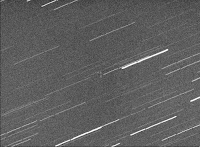Asteroid
2015 JD passed by the Earth at a distance of 1 366 000 km (3.55 times
the average distance between the Earth and the Moon, or 9.13% of the
average distance between the Earth and the Sun), at about 11.25 pm
GMT on Sunday 10 May 2015. There was no danger of the asteroid hitting
us, though had it done so it would have presented only a minor threat.
2015 JD has an estimated equivalent diameter of 15-47 m (i.e. it is
estimated that a spherical object with the same volume would be 15-47 m
in diameter), and an object of this size would be expected to explode in
an airburst (an explosion caused by superheating from friction with the
Earth's atmosphere, which is greater than that caused by simply
falling, due to the orbital momentum of the asteroid) in the atmosphere
between 26 and 10 km above the ground, with only fragmentary material
reaching the Earth's surface.
The calculated orbit of 2015 JD. JPL Small Body Database.
2015 JD was discovered on 7 May 2015 (three days before its closest approach to the Earth) by the University of Arizona's Catalina Sky Survey,
which is located in the Catalina Mountains north of Tucson. The
designation 2015 JD implies that it was the fourth asteroid (asteroid D) discovered in the First half of April 2015 (period 2015 J).
2015 JD has
an 531 day orbital period and an eccentric orbit tilted at an angle of 14.0° to the plane of the Solar System, which takes it from 0.996 AU from
the Sun (i.e. 99.6% of the average distance at which the Earth orbits the
Sun) to 1.57 AU from the Sun (i.e. 157% of
the average distance at
which the Earth orbits the Sun, more than the average
distance
at which the planet Mars orbits the Sun). It is therefore classed as an
Apollo Group
Asteroid (an asteroid that is on average further from the Sun than the
Earth, but which does get closer). This also means that close encounters
between 2015 JD and the Earth are quite common, with the last having
occurred in October 2002 next predicted for May 2028. The asteroid is
also predicted to have occasional close encounters with the planet Mars, with the last being thought to have occured in August 1992 and the next predicted for April 2062.
See also...
Asteroid
2015 JC1 passed by the Earth at a distance of 1 360 000 km (3.54 times
the average distance between the Earth and the Moon, or 9.09% of the
average distance between the Earth and the Sun), slightly after 5.50 pm
GMT on Friday 8 May 2015. There was no...
Asteroid
2015 HQ171 passed by the Earth at a distance of 446 400 km (1.16 times
the average distance between the Earth and the Moon, or 2.98% of the
average distance between the Earth and the Sun), slightly after 3.50 am
GMT on Saturday 2 May 2015. There was no danger of the asteroid hitting
us...
Asteroid
2015 FT33 passed by the Earth at a distance of 12 570 000 km (32.7
times the average distance between the Earth and the Moon, or 8.40% of
the average distance between the Earth and the Sun), slightly before
6.50 am GMT on Friday 1 May...
Follow Sciency Thoughts on Facebook.




